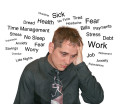5 Natural Ways to Fight Fibrocystic Breast Disease
Fibrocystic breast disease is a benign breast disorder, which means it is not harmful. The term “fibrocystic breast disease” is deceiving and, honestly, intimidating. It is based on this that many medical experts now refer this situation “fibrocystic change.”
If in any case you experience discomfort in your breasts area, do not panic. It may be wise not to immediately rule out that you have a benign breast condition. Just to rule out anything more serious, see your doctor and have a breast examination including a mammogram.
If your doctor finds your condition serious, don't despair, there are ways you can do to help yourself. The first thing that you need to look at is your diet. What is it? Do you need to make some changes? You definitely do!
Remember your B vitamins
When you think about estrogen, you don’t usually think about your liver. Some doctors however, link estrogen-related conditions like fibrocystic changes, to liver function. In order to keep your liver healthy, you obviously need B vitamins. In one study where the participants received B vitamin supplement, fibrocystic-change symptoms showed an improvement. Foods that are high in B complex vitamins are beans, peas, liver and whole grains. They help your body turn carbohydrates, fats, and protein into energy and they just might turn the tide against fibrocystic changes.
Consider vitamin E
There is some evidence that daily doses of vitamin E, between 100 and 1,200 international units (IU), can reduce the number of cysts you develop and even how large they become. If you plan to take supplements, be sure to check with your doctor about their effects on you. Vitamin E supplements have proven to raise blood pressure in certain people. Green and leafy vegetables, wheat germ, whole-grain products, nuts and seeds are good, safe ways to add vitamin E to your diet.
Get more magnesium
Some experts think a supplement of magnesium is helpful in treating breast cysts. The best sources of magnesium are legumes, whole grain, nuts, seafood and dark green vegetables. There are the natural sources of magnesium.
Do not ignore iodine
The mineral iodine may protect you from breast lumps and cysts. Studies show that if you don’t have enough iodine in your diet, you could be at a higher risk of developing fibrocystic changes. The suggested nutritional allowance for iodine is 150 micrograms. One cup of milk or a little less than a half teaspoon of iodized salt or an iodized salt substitute supplies close to the RDA. Other dietary sources are vegetables, seafood (especially halibut and cod liver), fish liver oils, eggs and bread. The antiseptic iodine, which is used on cuts and scrapes, is not the same thing and should not be taken internally.
Fight back with omega-3
One of the most annoying symptoms of fibrocystic change is painful breasts. You can control this discomfort by adding more omega-3 fatty acids to your diet. Fish oil is a wonderful source of these important nutrients. You can supplement with fish oil capsules, but a better solution is to get it naturally by eating cold-water fish. Try albacore tuna, lake trout, sturgeon, salmon and anchovies.








